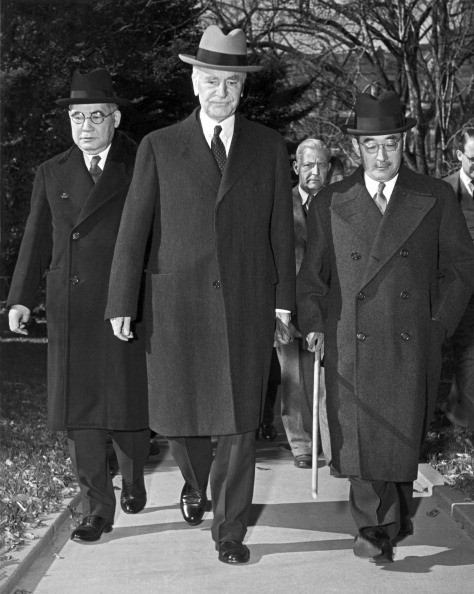
Saburo Kurusu (right) Japan’s special envoy for a ‘final attempt at peace,’ Secretary of State Cordell Hull, and Kichisaburo Nomura (left) Japanese Ambassador to the United States, arrive at the White House for a 70 minute conference with President Roosevelt, Washington DC, November 17, 1941. The President told them that he hoped a major conflict in the Pacific could be avoided. WikimediaCommons
By: Phil Kohn. Dedicated to the memory of his father, GM3 Walter Kohn, U.S. Navy Armed Guard, USNR, and all men and women who have answered the country’s call in time of need. Phil can be contacted at ww2remembered@yahoo.com.
On October 31, 1941, while escorting an eastbound convoy from Newfoundland, the American destroyer USS Reuben James is torpedoed and sunk by German submarine U-552 near Iceland, killing 115 of the crew of 159. This is the first loss of a U.S. Navy vessel in the European Theater of the war. The Luftwaffe flies 45 bombing sorties over Moscow. SS Gen. Erich von dem Bach-Zelewski reports to Berlin: “Today, there are no more Jews in Estonia.” Carving of the Mount Rushmore National Memorial, in the Black Hills of South Dakota, is completed. Construction had been started by Danish-American sculptor Gutzon Borglum in 1927, and was continued after his death (in March 1941) by his son, Lincoln Borglum.
On November 1 President Roosevelt announces that the U.S. Coast Guard will immediately move to the jurisdiction of the U.S. Navy — a transition of authority usually reserved only for wartime. German forces in the Crimea take Simferopol, an important communications center. The Rainbow Bridge over the Niagara River, connecting the U.S. and Canada, opens to traffic.
The Finnish conquest of East Karelia is completed on November 2 with the Soviet withdrawal from Kondopoga, in Russia. A Vichy French convoy of freighters and passenger ships is captured north of Madagascar by British cruisers.
The Germans take the Soviet city of Kursk, south of Leningrad, on November 3. They also cut the railroad line between Leningrad and Vologda at Tikhvin.
German advances in the Crimea continue, with the city of Feodosia, on the Black Sea coast, being captured on November 4. New regulations in Greater Germany deny Jews sick pay, accident insurance, vacation pay and pensions. They may be fired without notice and may not become apprentices. In the U.S., Fiorello LaGuardia is elected to a third term as mayor of New York City. Also holding the federal position of Director–Office of Civilian Defense, LaGuardia spends three days each week in Washington, D.C., and four in New York City.
From Tokyo, the Japanese government dispatches a top diplomat, Saburo Kurusu, to Washington on November 5 in an effort to negotiate a settlement with the United States on their various issues. In the meantime, U.S. code-breakers continue to intercept all Japanese diplomatic messages. In Japan, Adm. Isoroku Yamamoto issues to the Imperial Navy’s Combined Fleet Top Secret Order No. 1, detailing the plans for the attack on Pearl Harbor.
On November 6, Soviet leader Joseph Stalin addresses the people of the Soviet Union for only the second time since taking over the leadership of the country in 1922 (the first time being earlier this year, on July 2). He states that even though 350,000 Red Army troops have been killed in German attacks so far, the Germans have lost 4.5 million soldiers (a gross exaggeration) and Soviet victory is near. German troops begin experiencing frostbite on the Eastern Front. (Because the Germans expected the U.S.S.R. to fall within weeks of their invasion in June, many German troops have no winter clothing.) In Rivne, Ukraine, the Germans kill between 15,000 and 18,000 Jewish residents in a pine grove in nearby Sosenki Forest.







